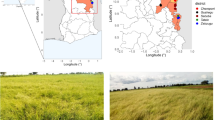Abstract
Small, finite populations are particularly vulnerable to diversity loss during regeneration. The regeneration of a highly outbreeding open-pollinated variety relies on estimated effective population size, via the measurement of temporal change in allele frequencies. Using appropriate estimators for dominant gene markers, effective sizes were calculated for five sizes of a mating population and two seed harvesting procedures. We have shown that, in the case of carrot regeneration, 70 equally harvested plants should provide an effective size (N e) of at least 50 plants. This value seems sufficient to limit genetic drift and to preserve an efficient level of genetic diversity within the collection. The efficiency of balanced samples (made of an equal number of seeds per plant) is compared to that of bulk samples (seeds randomly chosen among the total seed lot coming from all the plants).
Similar content being viewed by others
References
Astley D. 2000. The Future of European Carrot: A Programme to Conserve, Characterise, Evaluate and Collect Carrot and Wild Species. Technical progress report. Horticultural Research International, Wellesbourne, UK.
Breese E.L. 1989. Regeneration and Multiplication of Germplasm Resources in Seed Genebanks: The Scientific Background. IBPGR, Rome, 69 pp.
Briard M., Le Clerc V., Grzebelus D., Senalik D. and Simon P.W. 2000. Modified protocols for rapid carrot genomic DNA extraction and AFLPtm analysis using silver stain or radioisotopes. Plant Molecular Biology Reporter 18: 235–241.
Caballero A. 1994. Developments in the prediction of effective population size. Heredity 73: 657–679.
Crossa J., Hernandez M.C., Bretting P., Eberhart S.A. and Taba S. 1993. Statistical genetic considerations for maintaining germplasm collections. Theoretical and Applied Genetics 86: 673–678.
De Pace C., Monti L.M., Perrino P., Porceddu E., Spagnoletti Zeuli P.L. and Scarascia Mugnozza G.T. 1982. Theoretical aspects and practical implications of cross-pollination on seed regeneration of field crop genetic resources. In: Porceddu E. and Jenkins G. (eds), Seed Regeneration in Cross-pollinated Species Proceedings of the CEC/EUCARPIA Seminar, Denmark, 1981. A.A. Balkema, Rotterdam, The Netherlands, pp. 211–251.
Johnson R.C. 1998. Genetic structure of regeneration populations of annual ryegrass. Crop Science 38: 851–857.
Jorde P.E. and Ryman N. 1995. Temporal allele frequency change and estimation of effective size in populations with overlapping generations. Genetics 139: 1077–1090.
Jorde P.E., Palm S. and Ryman N. 1999. Estimating genetic drift and effective population size from temporal shifts in dominant gene marker frequencies. Molecular Ecology 8: 1171–1178.
Laikre L., Jorde P.E. and Ryman N. 1998. Temporal change of mitochondrial DNA haplotype frequencies and female effective size in a brown trout (Salmo trutta) population. Evolution 52: 910–915.
Marshall D.R. and Brown A.H.D. 1975. Optimum sampling strategies in genetic conservation. In: Frankel O.H. and Hawkes J.G. (eds), Crop Genetic Resources for Today and Tomorrow. Cambridge University Press, Cambridge, UK, pp. 53–80.
Noe F., Mercier V. and Briard M. 2001. The genetic resources of the carrot organize themselves. P.H.M. Revue Horticole 430: 36–38.
Nunney L. and Elam D.R. 1994. Estimating the effective population size of conserved populations. Conservation Biology 8: 175–184.
Oka H.I. 1983. Conservation of heterogeneous rice populations. Rice Germplasm Conservation Workshop held at the International Rice Research Institute, Philippines, 25¶26 April 1983. IRRI, Laguna, Philippines, pp. 11–19.
Sackville Hamilton N.R., Chorlton K.H. and Thomas I.D. 1998. Guidelines for the regeneration of accessions in seed collections of the main perennial forage grasses and legumes of temperate grasslands. In: Maggioni L., Marum P., Sackville Hamilton R., Thomas I., Gass T. and Lipman E. (eds), Report of aWorking Group on Forages. Sixth Meeting, 6¶8 March 1997, Beitostolen, Norway. IPGRI, Rome, Italy.
Vos P., Hogers R., Bleeker M., Reijans M., Van de Lee T., Hornes M. et al. 1995. AFLP: a new technique for DNA fingerprinting. Nucleic Acids Research 23: 4407–4414.
Waples R.S. 1988. A generalized approach for estimating effective population size from temporal changes in allele frequency. Genetics 121: 379–391.
Rights and permissions
About this article
Cite this article
Le Clerc, V., Briard, M., Granger, J. et al. Genebank biodiversity assessments regarding optimal sample size and seed harvesting techniques for the regeneration of carrot accessions. Biodiversity and Conservation 12, 2227–2236 (2003). https://doi.org/10.1023/A:1024562701150
Issue Date:
DOI: https://doi.org/10.1023/A:1024562701150




